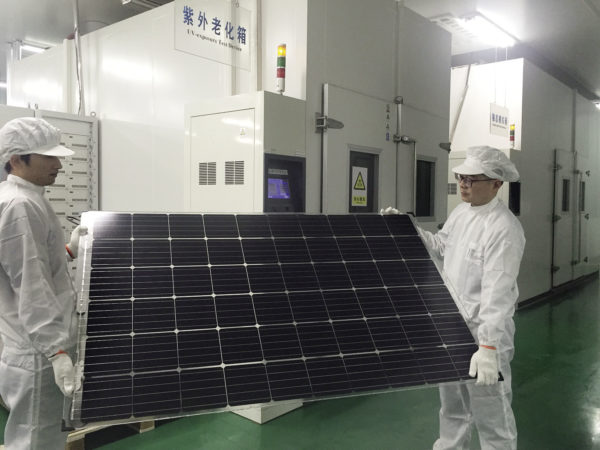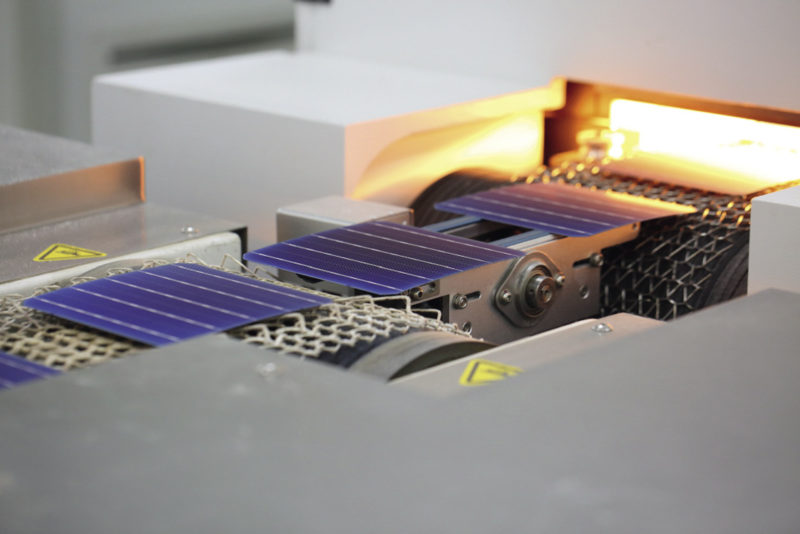At the beginning of November 2017, Chinese manufacturer JinkoSolar achieved a world record 23.45% cell efficiency for monocrystalline silicon-based passivated emitter rear contact (PERC) technology. Jinko’s competitor in the mono space, Longi Solar, is not far behind, having achieved 22.71% cell efficiency just a few weeks earlier. Thanks to advances in production tools for PERC technology delivering the highest cell efficiencies on an industrial scale, more and more module manufacturers are using PERC cells. This development is also evident in the PV cell technologies road map reported in the International Technology Roadmap for Photovoltaics (ITRPV) 2017, which forecasts that PERC/PERT/PERL technologies will cover more than a 55% market share by 2027. PERC is simpler than passivated emitter rear totally diffused (PERT) and passivated emitter rear locally diffused (PERL), which utilize complex backside passivation processes to reach even higher efficiencies.
EGing’s PERC transition
Chinese module manufacturer Changzhou EGing Photovoltaic Technology Co., Ltd., a vertically integrated PV company, prides itself on investing early in technology development and equipment improvement for its silicon ingot, wafer, cell, and module lines. It started R&D on PERC technology in 2012, and converted this to mass production in 2015. EGing has achieved a 21.4 – 21.8% efficiency for mono-PERC, and a 20.5% efficiency for black silicon multi-PERC at the module level. The company is planning to increase mono efficiency (mass production) to 22% in 2018.
According to Zhang Kaisheng, Vice Technical Director at EGing, “proved by facts, PERC modules can get 3 – 5% more output with higher performance. Even though PERC module costs are higher, still it is highly accepted by customers because of the lower LCOE compared with standard modules.”

Image: Eging
EGing plans to make the transition to producing exclusively PERC products from the beginning of next year. EGing has decided to stop using standard BSF cells, and update all production lines to PERC. Construction of the new lines is expected to be finished by December 2017. Then, the company’s total production capacity for PERC modules will be 2 GW.
Transition to p-type
EGing started R&D on glass-glass bifacial modules with n-type cells. However, according to EGing, compared to n-type, p-type cells save on raw materials cost (from silver paste to aluminum paste). Accordingly, the market eventually opted for p-type over n-type cells, which is confirmed by that fact that p-type cells hold almost 95% market share, based on the ITRPV 2017 road map. And for EGing, it was easier to change the existing PERC production lines to produce p-type bifacial cells.
Before that, in 2016, with the successful R&D of the p-type bifacial panels, EGing launched the Janus I production plan, due to the technical differences between n and p-type cells. Later, EGing improved on both cell and panel production to make it ideally matched with n-type production.
EGing is using PERC cells in its glass-backsheet (GB) and glass-glass (GG) modules. However, for GG production it is planning to use bifacial PERC cells. The company is going to launch a frameless glass-glass p-type bifacial module called Janus II in January 2018.
Janus II
Janus II utilizes p-type monocrystalline PERC cells produced by EGing with five busbars, which reach 21.4 – 21.8% efficiency. Modules will be available in 48, 54, 60, and 72 cell configurations. The 60 cell GG module boasts 20.1% module efficiency, with an expected output of 330+ W. The glass is patterned with anti-reflective coating (ARC) with 2.5 mm thickness for each pane. The encapsulant used is polyolefin elastomer (POE), a cured material with cross-linking agents to maintain the components’ stability under actual on-site conditions.
Due to changes in weather conditions, the module temperature can fluctuate to a significant extent. If the encapsulant is thermoplastic, the structure of the material may change and can create defects inside the module such as, for example, cell shifting.
With bifacial cells, the module generally exhibits a higher output compared to conventional GG modules. This is because the module absorbs both the light reflected on the back side of the module (due to the albedo effect), and the light passing through the front side and reflected back to the cell from the rear glass. According to EGing, its bifacial module can add 10 – 25% more output to the actual wattage from the front side, compared to mono-facial GG modules of the same wattage. This leads to the following performance boost: for 60 cell modules – front 305 W, back + 10 – 25% extra gain, so 30 – 75 W, leading to 335 + W total output; for 72 cell modules – front 365 W, back + 10 – 25% extra gain, so 35 – 90 W, leading to 400 + W total output. The rear glass has holes on the back side to take the ribbons out and typically to attach the junction box. Through continuous improvement of the manufacturing processes and the utilization of PERC technology, Janus II proved a success in its pilot production in early 2017.
AT A GLANCE
- Based on forecasts from the ITRPV, PERC technologies will hold a 55% share of the module market by 2027.
- China’s EGing is the latest module manufacturer to announce that it will abandon other cell concepts, to focus only on PERC production from the beginning of 2018.
- Its latest module, the Janus II, combines mono-PERC cells with glass-glass, bifacial, frameless, and five busbar technologies.
- The module is being sold as PID-free, thanks to the use of POE instead of EVA encapsulant.
- In a 72 cell layout, Janus II can achieve more than 400 W output.
Frameless and PID-free
The Janus II product is designed to achieve a significant balance of system (BOS) cost reduction for distributed power generation applications.
With a frameless design, there is no need for grounding, which makes the installation easier and the installed system more robust. Because of no grounding and no possibility of acetic acid formation, as no EVA encapsulant but POE is used, the module is PID-free. Since the module has a dual-glass configuration, it provides better resistance to fire, sand, and corrosion compared to conventional backsheet modules. According to EGing, with the enhanced performance, Janus II works well for a wide range of utility-scale, commercial, and residential applications to provide an enhanced internal rate of return (IRR) to customers and investors.
Market acceptance
Janus II has been tested and approved by the German institute VDE, to be in compliance with the IEC 61215 performance testing sequence for PV crystalline modules. However, these tests are not sufficient to ensure stable long-term performance in the field, especially in tropical conditions. Therefore, the manufacturer is planning to test the module at higher parameters than the IEC standards. Commenting on the PERC module’s acceptance in the market, Wei Zhong Yao, Vice General Manager at EGing, says, “According to customer feedback, mainly from state-owned enterprises and the central enterprises, EGing’s PERC modules achieved full power output due to the excellent material optimization and highly reliable performance.”
Equipment optimization
EGing has procured most of its production equipment from high-quality European tool makers. The most critical tools in module manufacturing are the stringer and the laminator. EGing has procured both from German manufacturers, namely the stringer from teamtechnik and the laminator from Robert Bürkle GmbH. In early 2010, EGing integrated a fully automated module assembly line together with Reis Robotics from Germany. With a total investment of $67 million, it was recorded as the most automated module assembly line of its size at that time.
When pv magazine spoke with teamtechnik’s China CEO Lingxiang Xu back in 2012, Xu described EGing’s production facility as follows: “The automation of the module production at EGing is in our opinion the most modern technology worldwide. By using this technology EGing achieves maximum flexibility in production, as well as the best quality of the modules and not least, the optimal cost structure.”
Production flexibility
EGing’s production lines were designed to be compatible with various products. The tooling was designed flexibly to switch from mono to multi, and from PERC to bifacial. Production lines of the p-type bifacial module are very compatible with the existing PERC production lines. Due to line optimization, the company can flexibly switch the production from mono to multicrystalline (and vice versa) according to customer demand, which presently stand at 50% each across the 2 GW capacity.
GG module complexity
Glass-glass module processing is not an easy task, and its lamination process is even more complicated. The right know-how and experience, however, can result in an excellent product. Though GG modules have proven advantages in the field, adoption in the market still lags behind, resulting in a GG market share of only 5 – 6% of the worldwide module market, according to the ITRPV 2017 road map. Many laminator companies have come up with specialized solutions to provide faster lamination for GG modules. In EGing’s case, the company is using a frame around the GG module to laminate it in a membrane press, so as to avoid the edge-pinching problem associated with GG modules. Therefore, the process time for Janus II GG module lamination is 23 minutes. Since the heat transferred to the module is only from one side, the process takes longer. Thus, to assure module quality, EGing tests the laminator’s heating plate temperature periodically, using a multi-channel temperature controller. In addition, Soxhlet gel content measurements are performed daily to ensure homogeneity.
The plan for 2018
With PV subsidies continuing to be reduced around the world, EGing aims to improve module performance and control the cost of raw materials continuously. “EGing will take advantage of mass production of PERC modules and the practical spirit to provide more cost efficient modules to customers,” Wei Zhong says. The manufacturer is planning to develop “intelligent manufacturing” and “green factory” concepts to achieve lower labor costs and sustainable development. Since 2015, EGing has been conducting R&D on new technologies, such as n-type cells, half-cut cells, and 12-busbar (multi busbar) technology, and it will continue these efforts in the coming years. Kaisheng says, “Regarding shingled cells, due to the current limits of equipment and production yield, we are now doing R&D together with high quality material and equipment suppliers.”
EGing is planning to integrate new technologies to produce PERC GG modules to achieve 10 – 15 W more power output, and bring these into mass production once market demand for such modules ramps up, and the process chain is improved. S
This content is protected by copyright and may not be reused. If you want to cooperate with us and would like to reuse some of our content, please contact: editors@pv-magazine.com.
